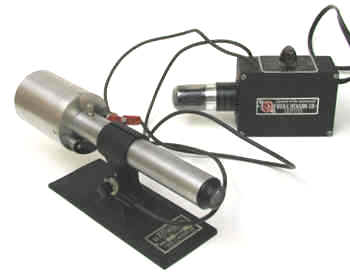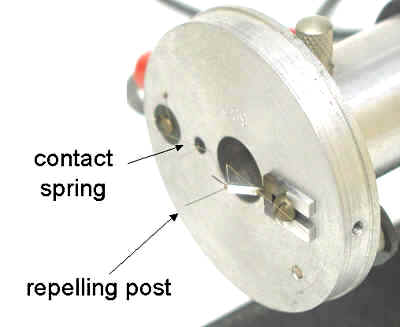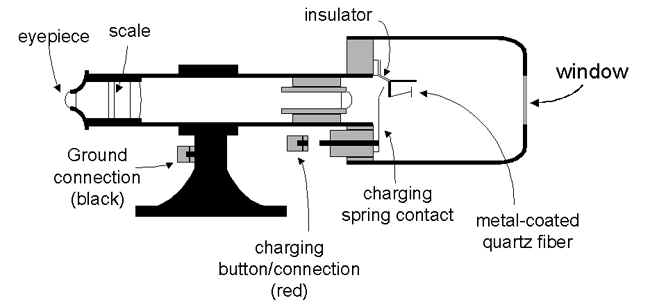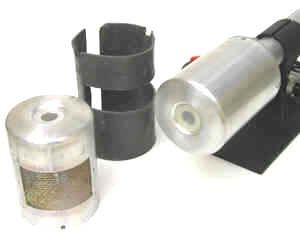Robley Evans' Lauritsen Electroscope (1940s)
This type of electroscope was designed in 1937 by Charlie Lauritsen specifically for the measurement of radiation (Lauritsen, C.C. Rev Sci. Instr. 8: 438). Produced by the Fred C. Henson Company of Pasadena, it became immensely popular. It had both the sensitivity required for use in the laboratory and the portability that allowed it to serve as a type of survey instrument—at the time no true survey instruments were commercially available. While better instruments came along, I knew one researcher at Oak Ridge National Laboratory who continued to use one of these as late as the 1970s.


The sensitive element is a very fine gold coated quartz fiber (invisible in the photo) that runs more or less parallel to what is known as the repelling post. The fiber and post, insulated from the body of the electroscope, are charged by a metal contact spring connected to a red charger button. When the latter is pushed, the spring (actually a fine metal wire), is brought into contact with the fiber and post. A microscope, with a scale in the eyepiece, is used to view the fiber. Actually, it views a tiny quartz fiber attached at a right angle to the tip of the gold coated fiber (together the gold coated quartz fiber and the attached fiber form a “T.”

Great care has to be exercised when removing the protective can over the end of the electroscope since small air currents can cause the fiber to become tangled around the repelling post. In addition, physical contact with the fiber can break the gold coating so that a uniform charge cannot be generated along its length.

This figure shows the window at the end of the ionization chamber, a lead shield for reducing its response to background gamma rays, and a replacement chamber housing with a thin window to permit alpha and beta counting.
Charging could be accomplished in a variety of way: via a friction charger, batteries, or as shown in the top photo, a vacuum tube rectifier.
The electroscope was typically calibrated with a radium source—its sensitivity might be expressed as so many (e.g., 3) divisions/minute at 1 meter from a 1 mCi source (ca. 0.85 mR/hr).
Donated by Robley Evans.
Robley Evans
Evans was among the first to accurately quantify radionuclides in the human body when he measured the radium uptake by radium dial painters in the early 1930s. At MIT (ca. 1934) he built what is usually considered the world's first whole body counter, also intended for measuring radium in the body. Indeed, the PET and SPECT systems of today's nuclear medicine departments are direct descendants of Evan's original counter. He promulgated the first limit for radioactive material in the body (0.1 uCi of Ra-226) and the first concentration limit for airborne radioactivity (10 pCi/l of Rn-222). In 1937 at the Massachusetts General Hospital, he was the first to employ Ra-226 for the treatment of hyperthyroidism. He also built the first count rate meter, an invention that made the survey instrument as we now know it possible.
